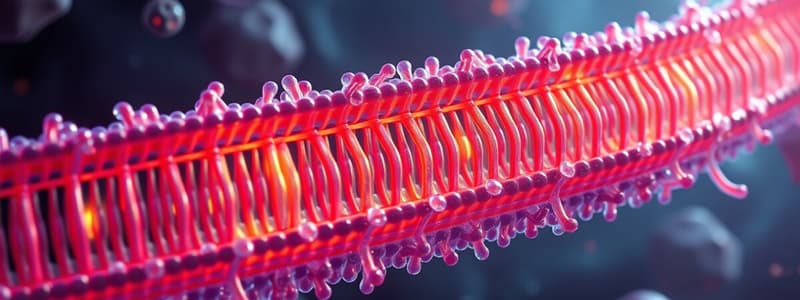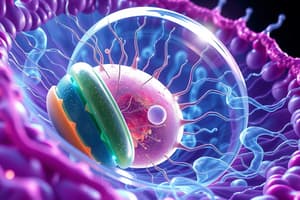Podcast
Questions and Answers
What type of molecules can easily cross the cell membrane via simple diffusion?
What type of molecules can easily cross the cell membrane via simple diffusion?
- Small nonpolar molecules (correct)
- Proteins
- Charged ions
- Large polar molecules
Transverse diffusion does not require enzymes to facilitate movement between the inner and outer layers of the membrane.
Transverse diffusion does not require enzymes to facilitate movement between the inner and outer layers of the membrane.
False (B)
What is the role of gap junctions in cell communication?
What is the role of gap junctions in cell communication?
Facilitating direct communication and ion flow between adjacent cells.
___ proteins facilitate processes such as exocytosis and endocytosis.
___ proteins facilitate processes such as exocytosis and endocytosis.
Match the following membrane protein functions with their descriptions:
Match the following membrane protein functions with their descriptions:
Which component of the cell membrane is primarily involved in maintaining fluidity?
Which component of the cell membrane is primarily involved in maintaining fluidity?
Integral proteins can only be found on the surface of the membrane.
Integral proteins can only be found on the surface of the membrane.
What are the two major types of fatty acids found in membrane lipids?
What are the two major types of fatty acids found in membrane lipids?
The __________ consists of a network of glycoproteins and glycolipids that form a protective layer on the cell surface.
The __________ consists of a network of glycoproteins and glycolipids that form a protective layer on the cell surface.
Match the following components of the cell membrane with their functions:
Match the following components of the cell membrane with their functions:
What effect do unsaturated fatty acids have on membrane fluidity?
What effect do unsaturated fatty acids have on membrane fluidity?
High temperatures always cause the phospholipids to compact, making the membrane rigid.
High temperatures always cause the phospholipids to compact, making the membrane rigid.
What is the role of the glycocalyx in immune response?
What is the role of the glycocalyx in immune response?
Flashcards are hidden until you start studying
Study Notes
Cell Membrane Overview
- Functions as a barrier separating intracellular and extracellular fluid.
- Composed of three main components: membrane lipids, membrane proteins, and glycocalyx.
Membrane Lipids
- Phospholipids: Key component of the bilayer; consist of hydrophilic phosphate heads and hydrophobic fatty acid tails.
- Fatty Acid Chains: Comprised of saturated (straight) and unsaturated (kinked) forms; hydrophobic, avoiding water.
- Cholesterol: Stabilizes the membrane and influences fluidity; helps maintain flexibility at varying temperatures.
Membrane Proteins
- Integral Proteins: Span the entire membrane; classify as transmembrane proteins, allowing transport across the membrane (e.g., ion channels).
- Peripheral Proteins: Attached loosely to the membrane surface; involve weaker interactions like hydrogen bonding.
Glycocalyx
- A glycoprotein and glycolipid network that forms a protective and sticky layer on the cell surface.
- Key roles include:
- Regulating water movement, preventing cell dehydration.
- Acting as an antigen recognition system, aiding immune response by differentiating between self and foreign cells.
Membrane Functions
- The glycocalyx's antigenic role aids in blood typing and compatibility; recognizes normal cells versus foreign elements.
- Membrane lipids play a significant role in maintaining fluidity, allowing dynamic cell shape changes and movements.
- Temperature and cholesterol presence are critical factors influencing lipid bilayer fluidity, impacting the membrane's overall function and adaptability.### Cell Membrane Stability and Fluidity
- Factors influencing membrane fluidity: temperature, cholesterol, and types of fatty acids.
- Increased fluidity occurs when there is more space between phospholipids, allowing for greater movement.
- High temperatures lead to increased fluidity, as phospholipids separate from each other.
- Low temperatures, especially without cholesterol, cause phospholipids to compact, making the membrane rigid.
- Cholesterol maintains membrane fluidity by acting like "glue," keeping phospholipids close together.
Fatty Acids and Their Impact
- Saturated fatty acids have straight chains, promoting tight packing, thus decreasing fluidity.
- Unsaturated fatty acids contain double bonds, creating "kinks" that increase spacing and fluidity in the membrane.
Transport Across the Cell Membrane
- Simple diffusion allows small, nonpolar, and lipid-soluble molecules (like oxygen and CO2) to easily cross the membrane.
- The lipid bilayer is hydrophobic; therefore, substances must dissolve within this component to pass through.
- Lateral diffusion allows phospholipids to move within the membrane, whereas transverse diffusion facilitates movement between inner and outer layers, relying on specific enzymes called floppases (inner to outer) and flipases (outer to inner).
Membrane Proteins and Functions
- Integral proteins include transmembrane proteins that form channels or carriers for larger polar and water-soluble molecules.
- Membrane proteins enable transport, facilitating movement of charged molecules and proteins across the membrane.
- Peripheral proteins facilitate processes like exocytosis (molecules leaving the cell) and endocytosis (molecules entering the cell).
Communication and Signal Transduction
- Membrane proteins enable cell communication through receptors that trigger intracellular responses upon binding with extracellular signals.
- Gap junctions allow for direct communication between adjacent cells, facilitating ion flow, particularly in muscle cells.
Enzymatic Activity
- Membrane proteins can function as enzymes, catalyzing reactions necessary for synthesizing substrates both inside and outside the cell.
Cell Attachment and Extracellular Matrix
- Membrane proteins help anchor cells to the extracellular matrix, providing stability.
- Hemidesmosomes are structures that connect epithelial cells to the basal lamina, enhancing tissue integrity.
Fluid Mosaic Model of the Cell Membrane
- The cell membrane comprises a lipid bilayer with hydrophilic heads facing external and internal aqueous environments and hydrophobic tails facing inward.
- Proteins embedded within the lipid layers contribute to the membrane’s flexible and mosaic-like nature, facilitating transport and communication.
Cell Membrane Overview
- Functions as a barrier, segregating intracellular fluid from extracellular fluid.
- Composed of membrane lipids, membrane proteins, and glycocalyx.
Membrane Lipids
- Phospholipids create the bilayer with hydrophilic heads and hydrophobic tails.
- Fatty Acid Chains can be saturated (straight) or unsaturated (kinked), influencing membrane characteristics.
- Cholesterol plays a crucial role in stabilizing the membrane, adjusting fluidity, and maintaining flexibility across various temperatures.
Membrane Proteins
- Integral Proteins penetrate the entire membrane, often functioning as transmembrane proteins for transport (e.g., ion channels).
- Peripheral Proteins are loosely attached to the membrane surface and interact through weaker bonds like hydrogen bonding.
Glycocalyx
- Formed by glycoproteins and glycolipids, creating a sticky layer that protects the cell.
- Regulates water movement, thus preventing dehydration and contributes to immune response by distinguishing self from foreign cells.
Membrane Functions
- Glycocalyx aids in blood typing and compatibility, influencing immune recognition.
- Membrane lipids promote fluidity, allowing flexibility in cell shape and movement in response to environmental changes.
- Temperature and cholesterol impact lipid bilayer fluidity, affecting overall membrane functionality.
Cell Membrane Stability and Fluidity
- Fluidity factors include temperature, cholesterol, and fatty acid types.
- Increased spacing between phospholipids correlates with greater fluidity.
- High temperatures enhance phospholipid separation, increasing fluidity, while low temperatures can compact phospholipids, making membranes rigid.
- Cholesterol maintains fluidity by stabilizing the phospholipid arrangement.
Fatty Acids and Their Impact
- Saturated fatty acids, with their straight chains, promote tight packing, reducing fluidity.
- Unsaturated fatty acids contain double bonds that introduce "kinks", increasing fluidity by creating extra spacing.
Transport Across the Cell Membrane
- Simple diffusion facilitates membrane crossing for small, nonpolar, and lipid-soluble molecules like oxygen and carbon dioxide.
- Lateral diffusion involves phospholipid movement within the membrane; transverse diffusion involves transition between inner and outer layers via enzymes (floppases and flipases).
Membrane Proteins and Functions
- Integral proteins function as channels or carriers for larger, polar, and water-soluble molecules.
- Membrane proteins are essential for the transport of ions and larger molecules across the membrane.
- Peripheral proteins are involved in processes such as exocytosis and endocytosis.
Communication and Signal Transduction
- Receptors within membrane proteins initiate intracellular responses upon binding to external signals.
- Gap junctions provide direct communication channels between adjacent cells, especially critical in muscle cells for ion flow.
Enzymatic Activity
- Membrane proteins can serve as enzymes, catalyzing reactions necessary for substrate synthesis both inside and outside the cell.
Cell Attachment and Extracellular Matrix
- Membrane proteins anchor cells to the extracellular matrix, enhancing structural stability.
- Hemidesmosomes anchor epithelial cells to the basal lamina, reinforcing tissue integrity.
Fluid Mosaic Model of the Cell Membrane
- Describes the membrane as a lipid bilayer with hydrophilic heads facing aqueous surroundings and hydrophobic tails oriented inward.
- Embedded proteins contribute to the membrane's dynamic and mosaic-like structure, facilitating transport and communication.
Studying That Suits You
Use AI to generate personalized quizzes and flashcards to suit your learning preferences.




